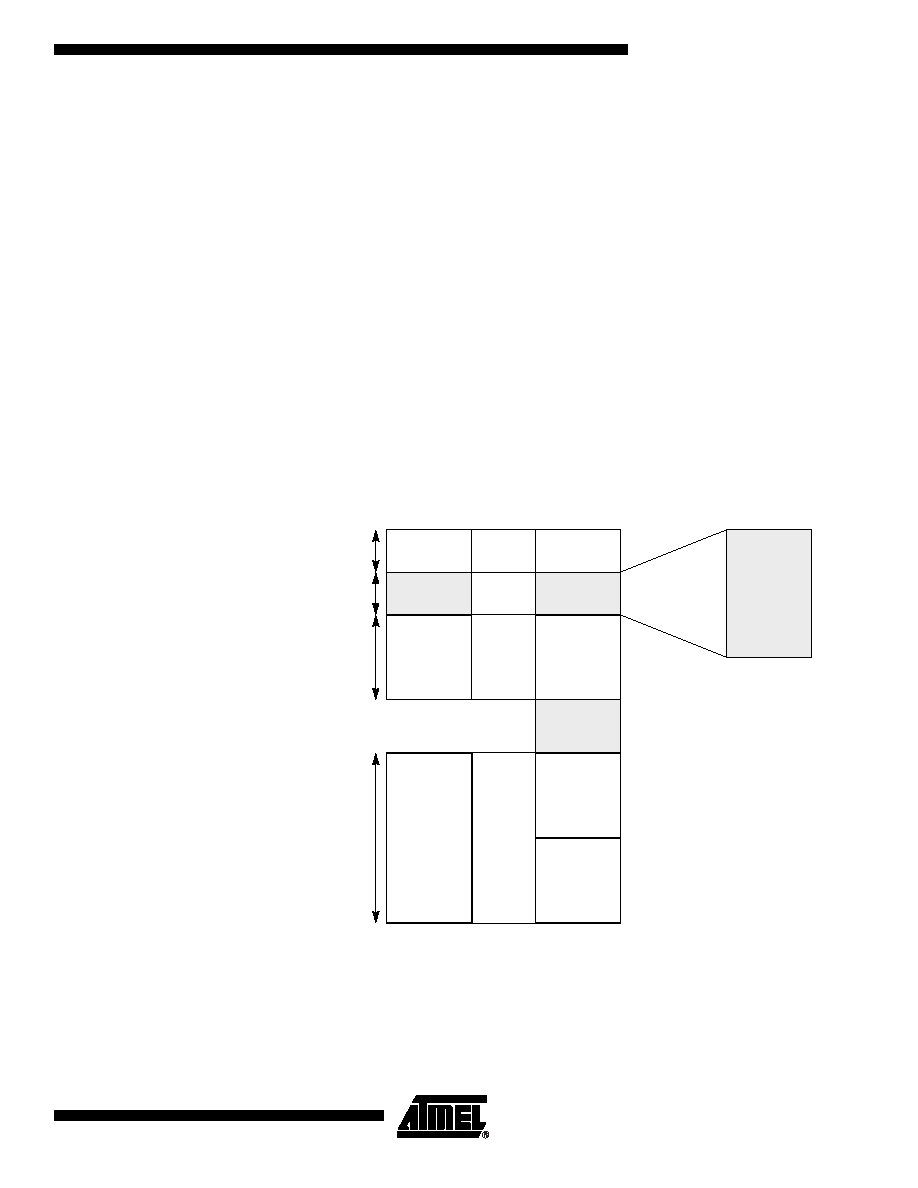- 您现在的位置:买卖IC网 > Sheet目录3833 > AT87251G2D-3CSUM (Atmel)IC 8051 MCU 32K OTP 24MHZ 40DIP

11
AT/TSC8x251G2D
4135F–8051–11/06
Address Spaces
The TSC80251G2D derivatives implement four different address spaces:
On-chip ROM program/code memory (not present in ROMless devices)
On-chip RAM data memory
Special Function Registers (SFRs)
Configuration array
Program/Code Memory
The TSC83251G2D and TSC87251G2D implement 32 KB of on-chip program/code
memory. Figure 4 shows the split of the internal and external program/code memory
spaces. If EA# is tied to a high level, the 32-Kbyte on-chip program memory is mapped
in the lower part of segment FF: where the C251 core jumps after reset. The rest of the
program/code memory space is mapped to the external memory. If EA# is tied to a low
level, the internal program/code memory is not used and all the accesses are directed to
the external memory.
The TSC83251G2D products provide the internal program/code memory in a masked
ROM memory while the TSC87251G2D products provide it in an EPROM memory. For
the TSC80251G2D products, there is no internal program/code memory and EA# must
be tied to a low level.
Figure 4.
Program/Code Memory Mapping
Note:
Special care should be taken when the Program Counter (PC) increments:
If the program executes exclusively from on-chip code memory (not from external mem-
ory), beware of executing code from the upper eight bytes of the on-chip ROM
(FF:7FF8h-FF:7FFFh). Because of its pipeline capability, the TSC80251G2D derivative
may attempt to prefetch code from external memory (at an address above FF:7FFFh)
and thereby disrupt I/O Ports 0 and 2. Fetching code constants from these 8 bytes does
not affect Ports 0 and 2.
When PC reaches the end of segment FF:, it loops to the reset address FF:0000h (for
On-chip ROM/EPROM
Code Memory
Program/code
Segments
Program/code
External Memory Space
32 KB
EA# = 0
EA# = 1
32 KB
Reserved
64 KB
128 KB
FF:FFFFh
FF:8000h
FF:7FFFh
FF:0000h
FE:FFFFh
FE:0000h
FD:FFFFh
01:FFFFh
01:0000h
02:0000h
00:FFFFh
00:0000h
发布紧急采购,3分钟左右您将得到回复。
相关PDF资料
AT80C51RA2-SLSUM
IC 8051 MCU ROMLESS 44PLCC
AT80C51RA2-SLSUL
IC 8051 MCU ROMLESS 44PLCC
AT80C51RA2-RLTUM
IC 8051 MCU ROMLESS 44VQFP
213931-5
CONN JACKSCREW RECEPT 34 POS
AT80C51RA2-RLTUL
IC 8051 MCU ROMLESS 44VQFP
AT80C51RA2-3CSUM
IC 8051 MCU ROMLESS 40DIP
AT80C51RA2-3CSUL
IC 8051 MCU ROMLESS 40DIP
AT80C31X2-SLSUM
IC 8031 MCU ROMLESS 44PLCC
相关代理商/技术参数
AT87251G2D-RLTUL
制造商:ATMEL 制造商全称:ATMEL Corporation 功能描述:B/16-BIT MICROCONTROLLER WITH SERIAL COMMUNICATION INTERFACES
AT87251G2D-RLTUM
功能描述:8位微控制器 -MCU 251G2D 8/16bitC OTP 5V RoHS:否 制造商:Silicon Labs 核心:8051 处理器系列:C8051F39x 数据总线宽度:8 bit 最大时钟频率:50 MHz 程序存储器大小:16 KB 数据 RAM 大小:1 KB 片上 ADC:Yes 工作电源电压:1.8 V to 3.6 V 工作温度范围:- 40 C to + 105 C 封装 / 箱体:QFN-20 安装风格:SMD/SMT
AT87251G2D-SLSUL
功能描述:8位微控制器 -MCU Microcontroller
RoHS:否 制造商:Silicon Labs 核心:8051 处理器系列:C8051F39x 数据总线宽度:8 bit 最大时钟频率:50 MHz 程序存储器大小:16 KB 数据 RAM 大小:1 KB 片上 ADC:Yes 工作电源电压:1.8 V to 3.6 V 工作温度范围:- 40 C to + 105 C 封装 / 箱体:QFN-20 安装风格:SMD/SMT
AT87251G2D-SLSUM
功能描述:8位微控制器 -MCU OTP 8/16bit St 5V 24MHz RoHS:否 制造商:Silicon Labs 核心:8051 处理器系列:C8051F39x 数据总线宽度:8 bit 最大时钟频率:50 MHz 程序存储器大小:16 KB 数据 RAM 大小:1 KB 片上 ADC:Yes 工作电源电压:1.8 V to 3.6 V 工作温度范围:- 40 C to + 105 C 封装 / 箱体:QFN-20 安装风格:SMD/SMT
AT875
制造商:POSEICO 制造商全称:POSEICO 功能描述:PHASE CONTROL THYRISTOR
AT875LT
制造商:POSEICO 制造商全称:POSEICO 功能描述:PHASE CONTROL THYRISTOR
AT875LTS44
制造商:POSEICO 制造商全称:POSEICO 功能描述:PHASE CONTROL THYRISTOR
AT875S44
制造商:POSEICO 制造商全称:POSEICO 功能描述:PHASE CONTROL THYRISTOR